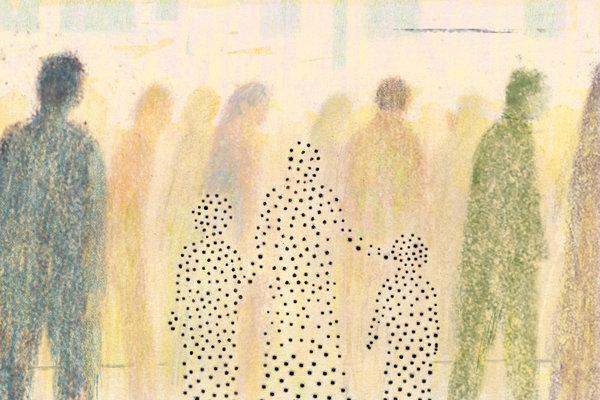
Passing My Disability Onto My Children
This article written by Sheila Black, who suffers from dwarfism, was published in the New York Times as part of their weekly series called Disability.
When I was pregnant with my first child, my ob-gyn referred me to a genetic counselor “just in case.”
I have a condition called X-linked hypophosphatemia, or XLH, which results in a form of dwarfism. I was a spontaneous case; there had no been no history of XLH in my family before me. No road map.
The counselor did not seem too worried. “Don’t sweat it,” he said. “Frankly, this is so rare, you’d have to marry a guy from the rickets clinic to pass it on.” I gave birth to my first child — my daughter Annabelle — seven months later. She did not have XLH.
Six years later, I stood in a neonatal intensive care unit looking down at my son, Walker. Because my husband and I had a rare blood incompatibility, he needed multiple transfusions. But what I was staring at as he lay in his incubator were his legs — something in them I recognized, a kind of curvature that felt as familiar to me as my own face.
“He has XLH,” I said to his doctor. She said, “I wouldn’t worry about that—we have enough here to worry about,” but a day later she found me in the hall. “You were right,” she said. “His phosphorus is very low. We’re pretty sure he has what you have.”
Because of a mutation on the PHEX gene, people with XLH don’t absorb phosphorus, resulting in short stature, bowed legs, soft bones and weak teeth. When I saw the genetic counselor before Annabelle was born, the genetics of my rare condition had not yet been mapped, and in fact, the counselor was wrong. I have a 50 percent chance of passing XLH on. And since the birth of my son, Walker, I’ve had another daughter, Eliza, who has XLH as well.
Several years ago, a relative of mine, who is quite religious in a way I am not, called me on the phone unexpectedly. She said she wanted to apologize because she had always thought that I should never have children; “God would not want you to have children” is how she put it. Yet now that I did have three of them — three “beautiful children,” she’d said — she wanted to let me know she had been wrong. It was a bit of an awkward moment, like when someone tells you look fabulous in a way that lets you know how terrible they thought you looked before.
When I found out Walker had XLH, I mourned briefly — mostly for the image I’d had of a tall, gangly teenager, the kind I had never been. But I never once regretted him or his XLH, and I certainly never imagined other people thinking about it or judging me for having had a child with a disability. Her words irked me, but eventually I understood that for an abled person — a person who considers herself “normal” — it is probably difficult to imagine taking the risk of passing on what is considered by most to be a fairly significant disability.
XLH patients, the Merck Manual of Diagnosis and Therapy tells us, are often quite robust apart from their short stature and odd side-to-side gait, and also the pain they suffer — muscle aches, bone aches, “quick to fatigue if asked to walk any distance.” My two younger kids and I all hover around five feet. This is not such a big deal for me and my daughter; it is more for my son, and all of us struggle to stand or walk for any length of time.
Occasionally, I come across the term “designer baby,” and I am reminded that some parents now have the option to screen or modify the genes of their unborn children to ensure or avoid certain traits. It always gives me a feeling of unease. Obviously, I did not take this route — partly because, at least with my son, I never had to actually make the decision. My third child, Eliza, was a late midlife accident. I chose to have her despite the possibility she would have XLH, but would I have made the same decision in a planned pregnancy or if given a choice much earlier in the process? I can’t help suspecting that because of advances in genetic mapping, genetic testing, the sheer range of prenatal choices, chances are that in a generation or two, there will be no one in the world who has XLH, no one who looks like me or my children — at least not in the so-called developed world — and I don’t know how to feel about that.
I am aware that some studies do show that short people score less points on “happiness scales,” whatever they may mean, but we are not the average study subjects. We are ourselves, individuals; we are what we are — short and proud of it. We are people with a disability.
Sometimes people stop us and ask us what is wrong with us; most of the time I can see that people notice, but they don’t say anything. Walker is more visibly disabled, which makes Eliza feel bad. She says sometimes she feels like a fraud because she has the same thing, but in her case “you almost can’t tell.” Walker rides a bicycle. Eliza does yoga. Both of them pursue these physical activities with fierce and single-minded passion. Both do so because there are other physical activities — walking, running — that they cannot pursue without difficulty. (Oddly, my least athletic child is my oldest, Annabelle, who regularly proclaims she hates all sports.)
Pain — both physical and psychic — is a part of my two younger kids’ daily experience, and it is the part that is hardest for me to get over. Perhaps this is what my relative meant. Perhaps sparing your loved one that psychic pain is the reason some people give their short-statured but otherwise perfectly healthy children human growth hormone, so they may grow just a few inches taller.
Most of the time I believe my children will transcend the parts of their disability that might make them suffer. Walker may be only five feet tall, but he is in every conceivable way an engaging personality. He has friends, wild schemes for the future, a wicked, deadpan sense of humor. Eliza is all darting motion — ups and downs. She sings in the shower; does cartwheels on the lawn. She also struggles with an eating disorder and anxiety. And Walker, normally even-keeled, occasionally gives in to fits of rage and frustration when, tired of the effort of simply moving through a day, or being left out at school, he punches walls, rides his bicycle too fast.
How much of this can I really blame XLH for? My oldest, Annabelle, would not say she has a perfect life. At 23, she is floundering a little — unsure what to do with her life or how. She adopts stray dogs. She gets tattoos. She works in a supermarket bakery and is struggling to finish college. She writes killer poems that are also very angsty.
Sure XLH has a cost, but so does life.
I know what the “designer baby” people would say: the more “advantages” — beauty, height, intelligence — the better the life chances, the better the life. But I am not sure I believe them.
Life is more than that.
Of course, I worry about Walker and Eliza. At the same time, I experience so keenly their blazing necessity, their utter beauty. Once I was walking along between them, and I realized all three of us possessed the same awkward-to-most-people “disabled” way of walking. The rush of identification I felt was almost triumphant. We don’t move like other people, I thought, and who is to say there are not things we have learned uniquely from our way of moving or being?
When I was a child in the 1960s, I used to hear or overhear dire predication about what kind of life I would lead because of my XLH. One teacher in my Catholic primary school said perhaps I should consider becoming a nun because I probably wouldn’t marry. A friend of my father’s encouraged me to go into biology because “girls who aren’t so pretty can still have a pretty terrific career in the sciences.” None of these dire predictions came true. I came to think of them as the empty curses of bad fairies; I was blessed, and cursed, to have in most ways an ordinary life.
As a young woman, I had an active sex life (something I’m sure people thought I wouldn’t have, but did not say). I had a few bad relationships, a few good ones.
Naturally, I wish better for my children — no psycho ex-boyfriends, no long-term affairs with nicotine or tequila, less time spent worrying about being cool, and more developing their inner resources. But I won’t be surprised if they make the same sorts of errors I did. XLH, or any disability, has a lot less to do with all of this than it might appear.
When I asked my children how they felt about the XLH I had passed on to them, both of them spoke of the disability as almost, though not quite, a gift. “It has made me not fit in,” Eliza said, “but it has taught me empathy.”
“I am sometimes bitter about being so short,” Walker said, “and about the pain, but I am very glad to be alive.”
Sheila Black is the author of three books of poetry, most recently, “Wen Kroy,” an editor of “Beauty Is a Verb: The New Poetry of Disability,” and the director of Gemini Ink, a literary arts center in San Antonio.



